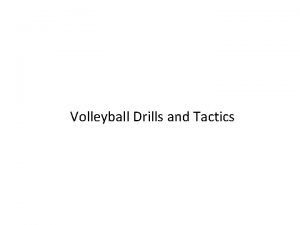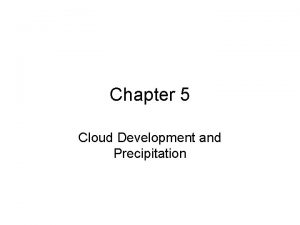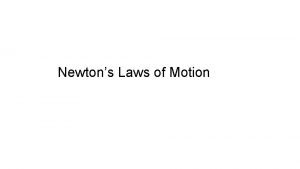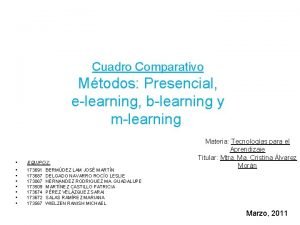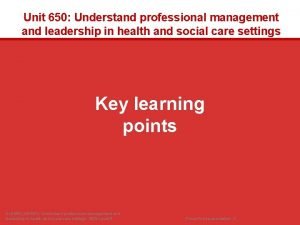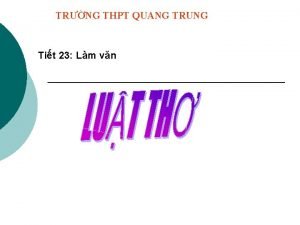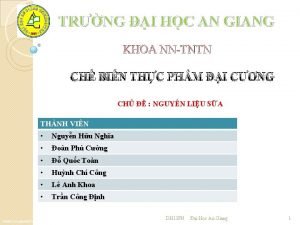Tipping Points in Language Learning The Law of










































- Slides: 42

Tipping Points in Language Learning The Law of the Few The Stickiness Factor The Power of Context

• Introductions • Key Factors/Three Rules of Epidemic – The Law of the Few – The Stickiness Factor – The Power of Context • Instructional Activities (Small Groups) • Debriefing/Open Discussion

What is “Tipping Point? ” - that magic moment when an idea, trend or social behavior crosses a threshold, tips and spreads like wildfire - possibility of sudden change is at the center of this tipping point idea, i. e. big changes occurring as a result of small events/little things can make a difference

At what point does it become obvious that something has reached a boiling point and is about to tip? How can we ensure that the unexpected becomes the expected?

Tipping Points in Language Learning

Tipping Points in Language Learning • • Learners learn how to learn Learning is realized Language progress is possible Both teaching and learning process demonstrates positive change

Key Factors in Reaching the Tipping Point • Caldwell suggested Three Rules of Epidemics – The Law of the Few – The Stickiness Factor – The Power of Context

The Law of the Few

• The 80/20 Principle – states that in any situation roughly 80% of the work will be done by 20% of the participants • Law of the Few Theory – where a tiny percentage of people do the majority of work

The Few in the Group How can a concept create an impact on the others in the group? Can the teacher create the buzz by her/himself? How can each of these few create a tipping point for the many?

Suggested Activities • Small Group activities – Two or three 10 -15 minute diverse interactive activities – Activity Log (individual learner) – Grammar Log (group)

Non-Traditional Assessment/Grammar Log Lesson Highlights Name: 1. Vocabulary and Idioms: Write here as many of the new words as you can remember from the lesson. _________________________________ 2. Structures: Note examples of new constructions learned today. Include brief statements about the grammar points they represent. ___________________________________

3. Conversation Strategies: What new expressions did you learn? What goals did these expressions accomplish? ______________________ 4. Matters that need more work: Note here in brief form any points you are still having trouble understanding. ______________________________________

Name: Daily Log: Day Monday Tuesday Wednesday Thursday Friday What task/activity did you do? Who are in your group? What did you learn?

Benefits of Small Group Acts. • Possibilities for more student-teacher interaction • Opportunities for students to become much more involved • Teacher/few students can provide guided practice and help struggling students

Sample Small Group Activities • Plan information Gap Type Activities • Plan discussions based on motivating topics that have already been covered in class • Use songs for teaching and encouraging selfexpression • Prepare for an oncoming tests. Review activities. (students love this!) • Create a mini-tutorial lesson in small group

• Mini Case Studies/Problem Based activities – e. g. travelling overseas, cooking for the inlaws, explaining your traditions to foreign friends, etc. • Role Playing Using Strategic Interaction Strategies/collaborative based activities – use of real life scenarios

• Timed Team Challenges – solving difficult issues in a crunch, record action plan and explain it with the class – e. g. grammar lesson and how to teach to a class of 7 th graders, etc. • Debates – stressing pros and cons; e. g. conflict of interest scenarios, customer service examples, etc. • Simulations – e. g. simulating a market, a work environment, family interactions, cooking, etc.

The Stickiness Factor - A message makes an impact and doesn’t go in one ear and out the other. - What makes a song or a movie line, TV commercial, etc. “sticky” and could not get out of your mind for a long period of time?

• What makes a message memorable? • What makes an event or something memorable because it irritated us so intensely? • Can something become sticky by information overload? Indecisions?

Ideas Promoting Stickiness • No Man is An Island – Work in Pairs or Small Groups! S • Hear and Visualize it! T/S

• Reflect and Assess! T/S • Plan diverse Instructional Activities. Involve students in planning and implementing. T/S

• Nobody is perfect. Teach tolerance and accept limitations. • Know your materials but do not be afraid to give “promisorry note”. Have students write difficult questions on paper. Post these on an online blackboard or chat rooms.

The Power of Context

What is the power of context? • - it infers that epidemics (+/-) are sensitive to the conditions and circumstances of the times and places in which they occur. • Are certain individuals more sensitive to their environment than others? • To what extend does the environment dictate ones’ behavior?

Inspire! (In the Target Language) • Change will not come if we wait for some other person or some other time. We are the ones we've been waiting for. We are the change that we seek. (Barack Obama) • Be the change that you want to see in the world. (Gandhi) • We have it in our power to begin the world over again. (Thomas Paine) • What we obtain too cheap, we esteem too lightly; it is dearness only that gives everything its value. (Thomas Paine)

Ideas to Power the Context • Energize the classroom environment!

• Promote Positive and Critical Thinking

• Appreciate Learning and the Learner

• Promote Good Citizenship

• Create a community of learners

Tipping Point indicates ……. .

Tipping Point Activities Problem Based Activity. Scenario 1: You are a young executive in a large firm. You invited a client to dinner to an expensive restaurant. If you can impress the client, you might win a large account, get a promotion and raise. As the dinner progresses, you discovered that you left your wallet with credit cards at home. What do you do?

Problem Based Solutions/Different Modes • Analytic: Outline what all the option are and decide which will be the least stressful • Idealistic: Attempt to gain the guest’s sympathy. Perhaps he/she has been in similar situation and will understand • Pragmatic: Be resolved to accept the situation as it is. These things do happen and perhaps one can joke about the set of circumstances

• Realistic: The problem is not really so bad, after all. Perhaps the client will lend the money. Then he or she can be asked to stop off at home for a nightcap. A check could be written and given to the client at that time. • Synthesist: The manager of this restaurant probably has had customers in similar situation before. If he can be assured of one’s good intentions, the money could be sent first thing in the morning.

Example 2: Collaborative Based • Goal: To supply factual information in a predetermined format • A is hurrying to keep an important appointment with her attorney. As she turns left at a busy intersection, her car is struck on its right side by another vehicle driven by B. B is on his way to meet his boss, who is impatiently waiting at the airport.

In the ensuing exchange between A and B, each blames the other for the accident. A insists that the traffic light was in her favor, indicating permission to turn left. B claims that the traffic light had already changed and allowed him to continue through the intersection. As the confrontation continues, a police officer arrives to investigate.

Possible Small Group Acts. • Strategic Interaction – roleplay with a plan and much coaching Roles: A B Police Officer Witness/es

Writing an accident report (A, B, Police Officer, Witness) • Illustrate the accident. Use rectangles to represent the vehicles. Mark yours with an X. • Draw an arrow in the upper left hand corner to indicate north. • Position vehicles at the point of impact. Questions to Answer: 1. What time of the day did the accident occur? 2. What were the weather conditions?

3. How fast were you going? In your own words, describe the events of the accident as you remember them: _____________________________________

Open Discussion in Small Group Questions to Ponder: • Is a positive “Tipping Point” a possibility in your language classroom? • What are these tipping points? • What encourage these tipping points? Lecture Based? Problem Solving Based? Collaborative Based? Small Group? . .

Salamat! Thank you! Rhodalyne Crail rgallocrail@niu. edu Get Published! Submit articles, reviews and lesson plans/activities to the COTSEAL Journal, JSEALT at www. seasite. niu. edu/jsealt 1@att. net
 Tipping problem
Tipping problem St helen’s smelting co v tipping (1865)
St helen’s smelting co v tipping (1865) Bangalore method of waste disposal
Bangalore method of waste disposal Tipping point hush puppies
Tipping point hush puppies Tipping of tooth
Tipping of tooth Eco tipping point
Eco tipping point Volleyball tipping drills
Volleyball tipping drills Rain gauge tipping bucket
Rain gauge tipping bucket Blizzardsleet
Blizzardsleet What is tipping point
What is tipping point Mark alpert tipping point
Mark alpert tipping point Envirepel
Envirepel Brand positioning bullseye
Brand positioning bullseye Point of difference and point of parity
Point of difference and point of parity Newton's first law and second law and third law
Newton's first law and second law and third law Newton's first law and second law and third law
Newton's first law and second law and third law Boyles law
Boyles law Constant of avogadro's law
Constant of avogadro's law Cuadro comparativo de e-learning b-learning y m-learning
Cuadro comparativo de e-learning b-learning y m-learning Language acquisition vs language learning
Language acquisition vs language learning Scienze della formazione
Scienze della formazione Unit 650 understand professional management
Unit 650 understand professional management Hát kết hợp bộ gõ cơ thể
Hát kết hợp bộ gõ cơ thể Frameset trong html5
Frameset trong html5 Bổ thể
Bổ thể Tỉ lệ cơ thể trẻ em
Tỉ lệ cơ thể trẻ em Gấu đi như thế nào
Gấu đi như thế nào Tư thế worms-breton
Tư thế worms-breton Chúa yêu trần thế
Chúa yêu trần thế Các môn thể thao bắt đầu bằng từ đua
Các môn thể thao bắt đầu bằng từ đua Thế nào là hệ số cao nhất
Thế nào là hệ số cao nhất Các châu lục và đại dương trên thế giới
Các châu lục và đại dương trên thế giới Cong thức tính động năng
Cong thức tính động năng Trời xanh đây là của chúng ta thể thơ
Trời xanh đây là của chúng ta thể thơ Mật thư tọa độ 5x5
Mật thư tọa độ 5x5 Làm thế nào để 102-1=99
Làm thế nào để 102-1=99 độ dài liên kết
độ dài liên kết Các châu lục và đại dương trên thế giới
Các châu lục và đại dương trên thế giới Thơ thất ngôn tứ tuyệt đường luật
Thơ thất ngôn tứ tuyệt đường luật Quá trình desamine hóa có thể tạo ra
Quá trình desamine hóa có thể tạo ra Một số thể thơ truyền thống
Một số thể thơ truyền thống Cái miệng nó xinh thế chỉ nói điều hay thôi
Cái miệng nó xinh thế chỉ nói điều hay thôi Vẽ hình chiếu vuông góc của vật thể sau
Vẽ hình chiếu vuông góc của vật thể sau






